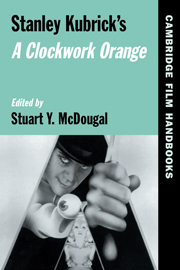Book contents
- Frontmatter
- Contents
- Acknowledgments
- List of Contributors
- Introduction: “What's it going to be then, eh?”: Questioning Kubrick's Clockwork
- 1 A Clockwork Orange … Ticking
- 2 The Cultural Productions of A Clockwork Orange
- 3 An Erotics of Violence: Masculinity and (Homo)Sexuality in Stanley Kubrick's A Clockwork Orange
- 4 Stanley Kubrick and the Art Cinema
- 5 “A Bird of Like Rarest Spun Heavenmetal”: Music in A Clockwork Orange
- REVIEWS OF A CLOCKWORK ORANGE, 1972
- A Glossary of Nadsat
- Filmography
- Select Bibliography
- Index
- References
2 - The Cultural Productions of A Clockwork Orange
Published online by Cambridge University Press: 29 January 2010
- Frontmatter
- Contents
- Acknowledgments
- List of Contributors
- Introduction: “What's it going to be then, eh?”: Questioning Kubrick's Clockwork
- 1 A Clockwork Orange … Ticking
- 2 The Cultural Productions of A Clockwork Orange
- 3 An Erotics of Violence: Masculinity and (Homo)Sexuality in Stanley Kubrick's A Clockwork Orange
- 4 Stanley Kubrick and the Art Cinema
- 5 “A Bird of Like Rarest Spun Heavenmetal”: Music in A Clockwork Orange
- REVIEWS OF A CLOCKWORK ORANGE, 1972
- A Glossary of Nadsat
- Filmography
- Select Bibliography
- Index
- References
Summary
This is Stanley Kubrick. He produced, wrote the screenplay for and directed A Clockwork Orange. I'm not sure that Kubrick sees himself as a practitioner of the Ludovico Technique, but I think he comes very close. Has it occurred to anyone that, after having our eyes metaphorically clamped open to witness the horrors that Kubrick parades across the screen, like Alex and his adored 9th, none of us will ever again be able to hear “Singin' in the Rain” without a vague feeling of nausea?
– Susan RiceWhat precisely might be the effects of watching A Clockwork Orange has preoccupied several decades of film scholars. Does the film romanticize and then excuse violence? Could it create a questioning of authorities? Is its effect more devastating, as Susan Rice suggests: the unsettling of a pure pleasure in watching Gene Kelly dance? And why did A Clockwork Orange become such a favorite among the cult audiences of the 1970s and later
This essay will not answer any of these questions. What it will attempt is to place the U.S. public critical reception of A Clockwork Orange in parts of its cultural context with the hope that understanding some of the dynamics and tensions existing within the moment of the film's release will provide a description of some associations available to a film viewer of the era. These contextual associations would have a bearing on eventually answering questions about effect.
- Type
- Chapter
- Information
- Stanley Kubrick's A Clockwork Orange , pp. 37 - 60Publisher: Cambridge University PressPrint publication year: 2003



